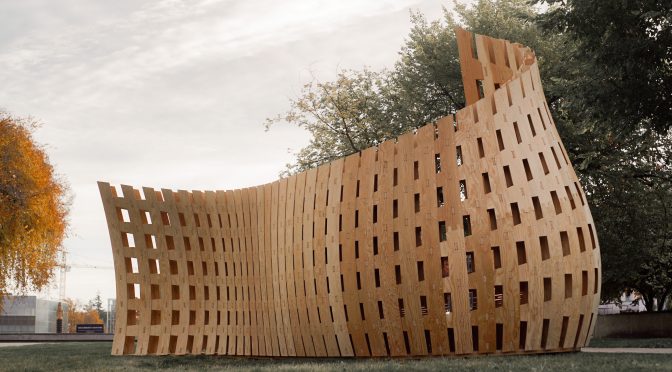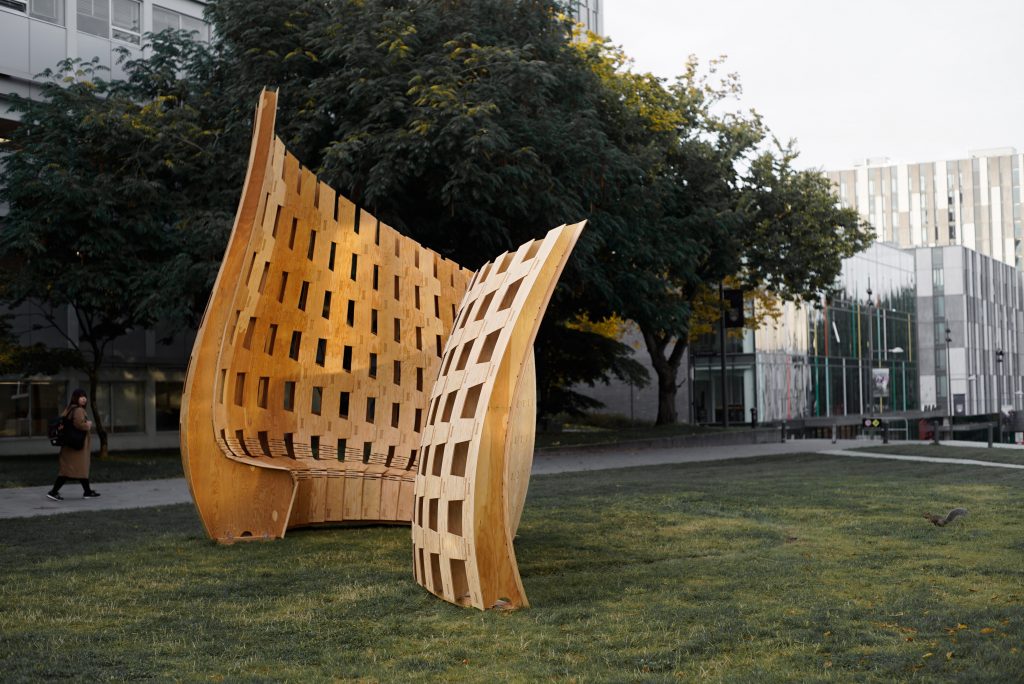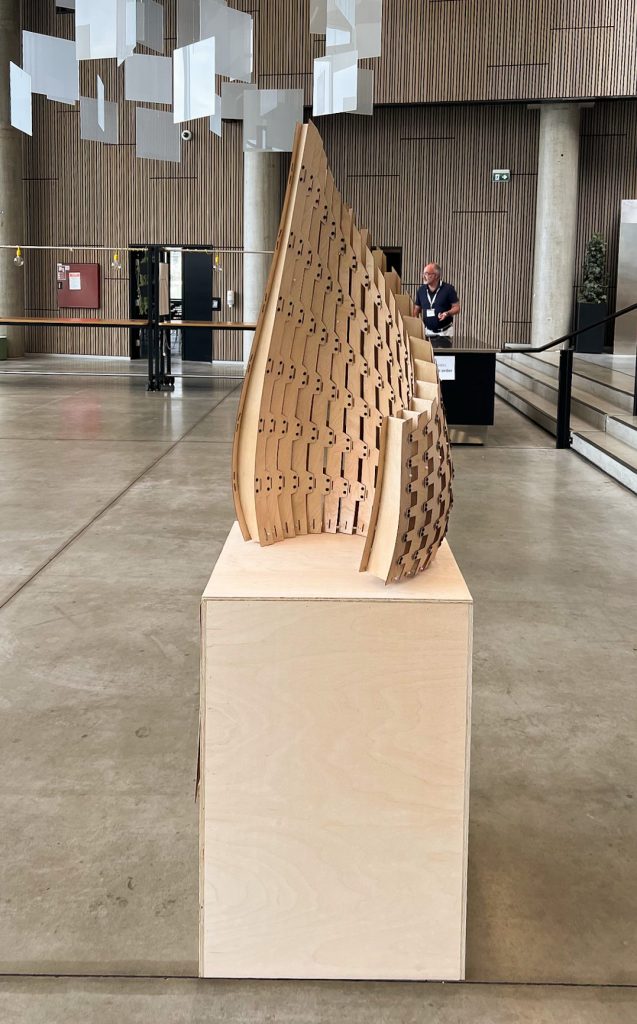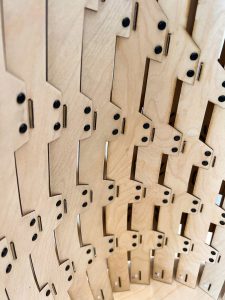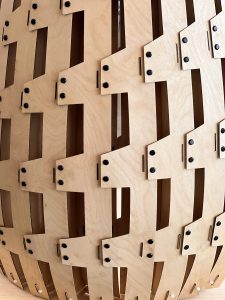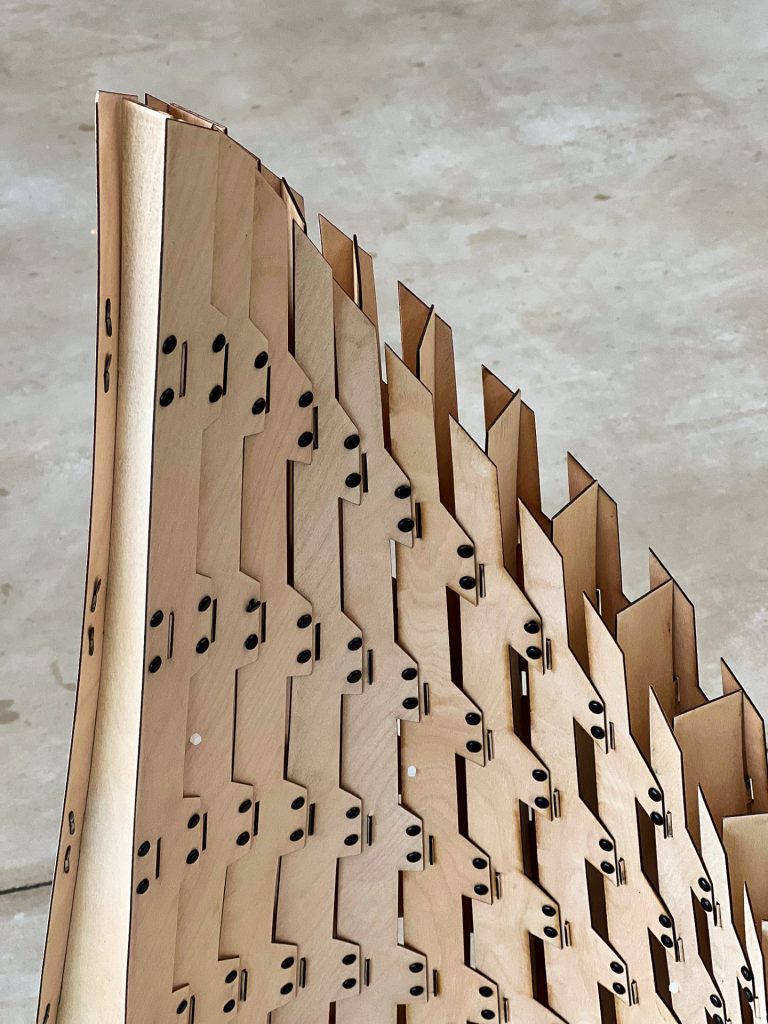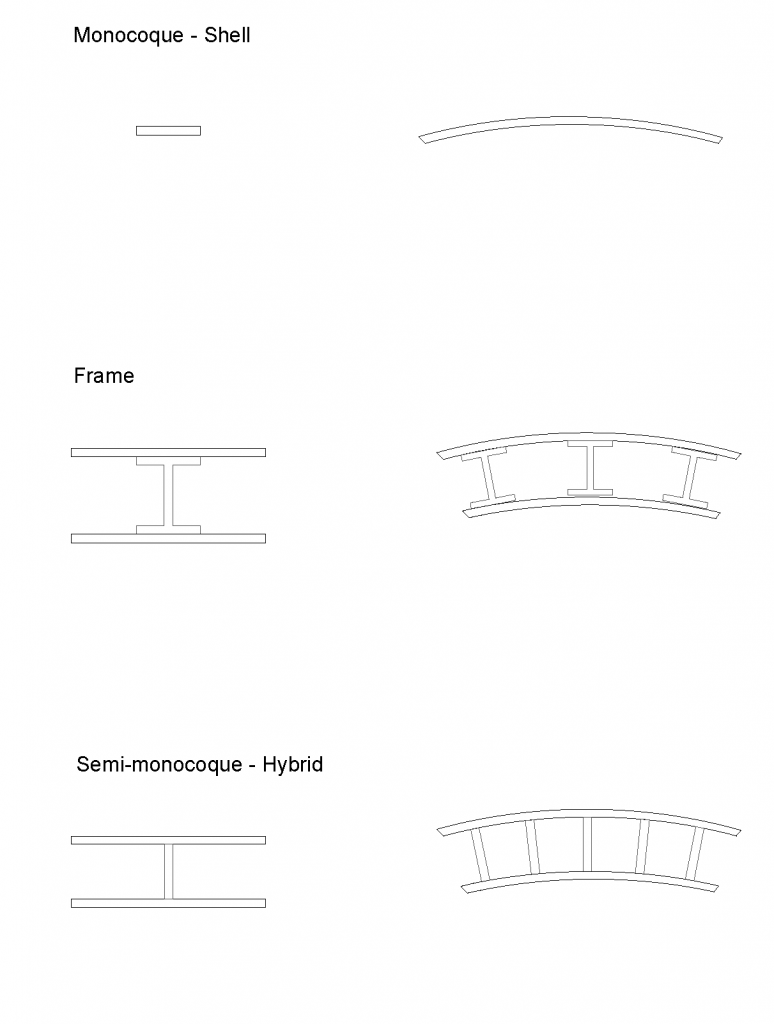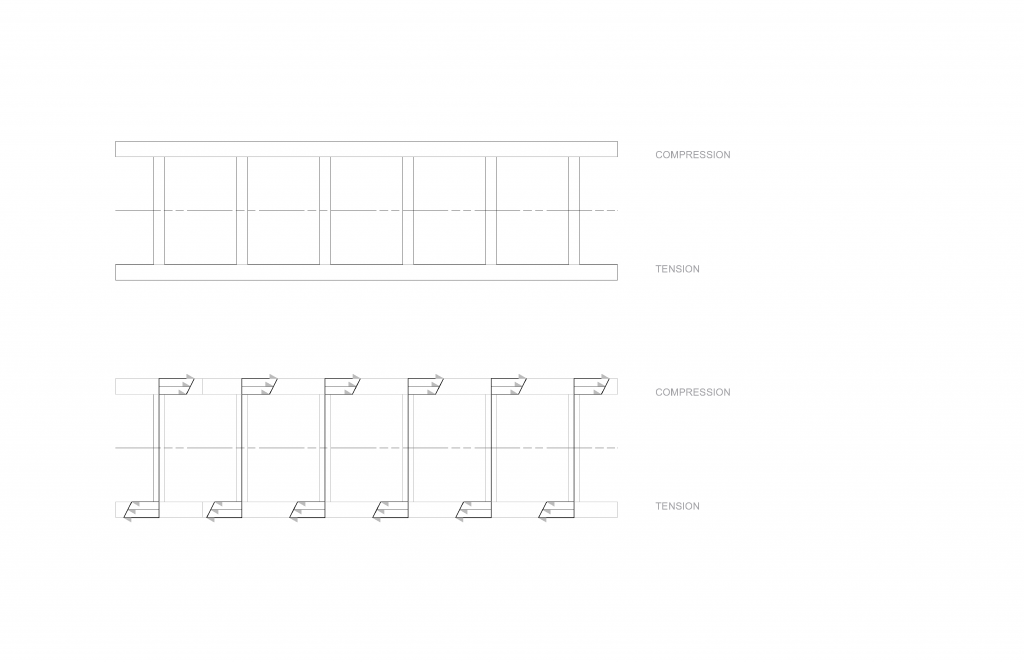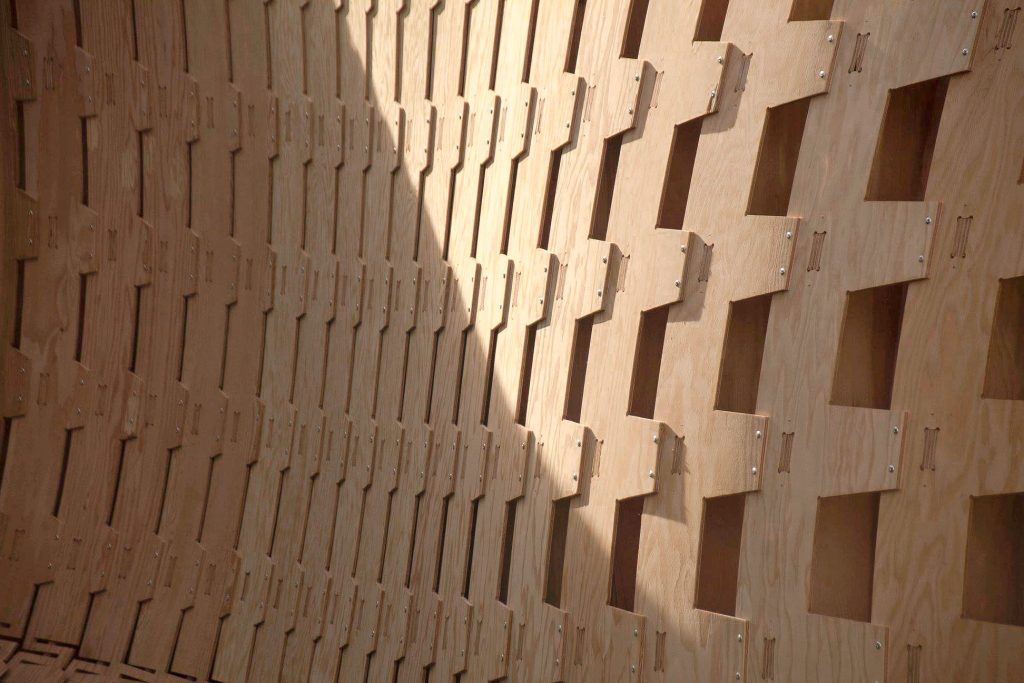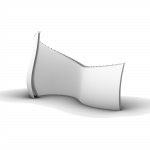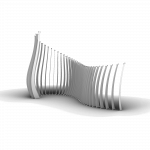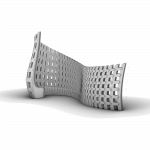AnnaLisa Meyboom, University of British Columbia, Canada
David Correa, University of Waterloo, Canada
Oliver David Krieg, Intelligent City
Full scale prototype built at UBC campus
Paper from ACADIA Conference
Stressed Skin Wood Surface Structures: Potential Applications in Architecture
An Installation for the ICSA Conference Aalborg, Denmark
Advanced parametric tools and fabrication equipment give us the ability to design and build novel geometries. In the structural system showcased here, these advanced approaches are combined with the traditional ‘stressed skin’ structure and the material wood to create a structurally efficient and architecturally useful construction.
This prototype aims to be a proof of concept that demonstrates the ability of the stressed skin wood structure to deal with double curvature while exhibiting its great design flexibility. It demonstrates an adaptive architectural system with unique potential for wood.
1 History and Background of the Stressed Skin
The stressed skin wood structure is a historically known form of wood construction used to make double curved surfaces. Stressed skin structures have primarily been used in engineering applications of moving objects such as boats, planes and spaceships because of the necessity for curved lightweight, strong and aerodynamic shapes. The advantage of the stressed skin is that, unlike a monocoque shell, it has a depth for resisting bending forces however it does not duplicate the material required for flanges in a frame structure (see Figure 01a).
Figure 01(a): Types of shell structures
Figure 01(b)Principle of a stressed skin
The idea of a stressed skin was first referred to in 1849 by Fairbairn. The first use in England and one of the more famous uses is in the Mosquito Bomber [R.J. Vinson, n.d. 202], an all-wood construction. At the same time in the USA, Wright Patterson Air Force Base designed and fabricated the Vultee BT-15 fuselage using fiberglass-reinforced polyester as the face material and using both glass-fabric honeycomb and balsa wood core (J. R. Vinson, n.d., 202). The first paper regarding this type of structure was published in 1944 by Marguerre dealing only with in-plane bending stresses (Marguerre 1944) but the technology developed quickly and by the 1960s there were over 250 publications available (J. Vinson and Shore 1965).
This type of structure is used in applications in engineering where high strength and light weight structures are required, especially in curved applications. The American space shuttles and modern aircraft such as the 707, 747, 757, and 767, as well as all satellites use stressed skin structures. These are also referred to as sandwich panels and double hull construction (with some distinctions). The stressed skin consists of exterior skins which functions as flanges and an interior repeating web that connects the flanges and transfers shear so that the complete element takes bending in an efficient way. The flange skins provide the continuity connecting the structure together (See Figure 01b).
2 CREATING DOUBLE CURVATURE
The double curvature is achieved by the same mechanism that was used by the Eames elephant: since plywood bends only in one direction then one direction of curvature is used as the first direction of curvature and the second direction of curvature is provided by the ‘tabs’ which allow localized bending in the secondary direction. (see Figure 02). In the protoype and exhibition piece this is exaggerated but at the scale of a building it would be even more easily achieved.
Figure 02: Double curvature through localized bending of tabs in prototype
3 Technical Design and Fabrication
The fabrication of the demonstration project was done using a Kuka robot with a 6m track set up. The demonstrator was composed of 100 overlapping skin elements made from ¼” plywood and 50 ribs fabricated with ¾” plywood. Assembly information was embedded in the form of pre-drilled fastening guides as well as prefabricated slots for the connection of webs and flanges. With these in place and tracking of the pieces, assembly was quick and required no manual measurement. Local differentiation was created along its length using graphing functions to vary the spacing of the planks. Geometrically, the system also integrates double curvature changes along its length from synclastic (Figure 03 taller end ) to anticlastic (Figure 03 – near the lower section of the design).
Figure 03: Variations in curvature across the structure
The parametric design was created as a structural system that could be replicable on any surface. The component based system with its flanges and webs is replicated over any given surface through the use of section curves perpendicular to the base tangent curve (See Figure 04).
Figure 04: Generation of the parametric form of the model
4 Application at the Architectural Scale
The application of the stressed skin structural principle to architecture is common in steel fabricated components but not in wood. While the system was initially developed in wood structures, its applications in timber constructions are not widely known or used. This is likely because the need for systems that deal with double curved structures has not been needed, or steel construction has been used instead. To build such complex geometry, the geometry control must be embedded within the logic of the structural system and it has to be compatible with the other systems that are being integrated. However, there are significant architectural benefits to the application of a stressed skin system in building design and construction. The system is uniquely suited to address complex geometries (as demonstrated) while it is also robust and lightweight. The stressed skin system is well suited for assembly in sections and provides ample design flexibility to integrate lighting, mechanical and electric services through the interstitial space of the web assembly. The exterior surfaces can also be cut, as determined by structural configurations, to allow apertures for windows. The veneer finish of the wood allows the plywood interior surface to be left as the surface finish and the exterior surface can provide the base for cladding.
5 Conclusion
This prototype aims to be a proof of concept that demonstrates the ability of the stressed skin wood structure to deal with double curvature while exhibiting its great design flexibility. The functional variation of the tabs in conjunction with the sinuous double curved geometry present a compelling material tectonic with great architectural appeal. The demonstrator engages advanced design and fabrication tools to celebrate the integral properties of the materials and their structural capacities. It demonstrates an adaptive architectural system with unique potential for wood.
6 References
Marguerre, K. 1944. “The Optimum Buckling Load of a Flexibly Supported Plate Composed of Two Sheets Joined by a Light Weight Filler When under Longitudinal Compression, .” Deutsche Viertaljahrsschrift Fur Literaturwissenschaft Und Giests Geschichte (DVL) ZWB UM1360/2 (October).
Vinson, Jack R. 2001. “Sandwich Structures.” Applied Mechanics Reviews 54 (3): 201–14. https://doi.org/10.1115/1.3097295.
Vinson, JR, and S Shore. 1965. “Bibliography on Methods of Structural Optimization for Flat Sandwich Panels.” NAEC-ASC-1082. Naval Air Engineering Center.

